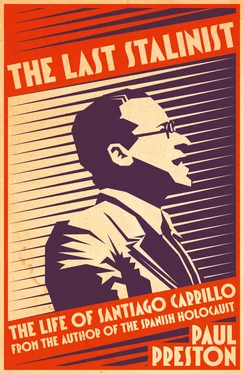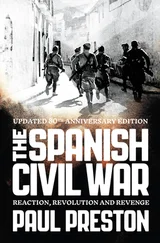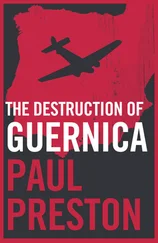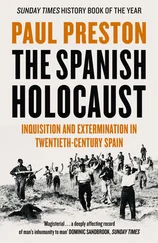Within four years of the establishment of Primo de Rivera’s dictatorship, the economic boom that had facilitated Socialist collaboration was coming to an end. By the beginning of 1928, significant increases in unemployment were accompanied by growing evidence of worker unrest. The social democratic positions of Prieto and De los Ríos were gaining support. They constituted just one of the three tendencies within the Socialist movement whose divisions had been exacerbated by the dictatorship. The deteriorating economic situation confirmed both Prieto and the deeply reformist and rigidly orthodox Marxist Besteiro and Saborit in their respective positions. However, as the recession changed the mood of the Socialist working masses, it inevitably affected the views of the pragmatic trade unionists under Largo Caballero. That necessarily included his lieutenant Wenceslao Carrillo. They had gambled on securing for the UGT a virtual monopoly within the state industrial arbitration machinery, but it had done little to improve recruitment. Indeed, the small overall increase in membership was disappointing relative to the UGT’s privileged position. Moreover, there was a drop in the number of union members paying their dues in two of the UGT’s strongest sections, the Asturian miners and the rural labourers. 20Always sensitive to shifts in rank-and-file feeling, Largo Caballero began to rethink his position and reconsider the advantages of a rhetorical radicalism. Since Wenceslao Carrillo spoke freely with his thirteen-year-old son, it is to be supposed that the beginnings of Santiago’s own extremism in the period between 1933 and 1935 may be traced to this period. The difference would be that he believed in revolutionary solutions whereas Largo Caballero merely used revolutionary language in the hope of frightening the bourgeoisie.
At the Twelfth Congress of the PSOE, held in Madrid from 9 June to 4 July 1928, Prieto and others advocated resistance against the dictatorship, and a special committee created to examine the party’s tactics rejected collaboration by six votes to four. Nevertheless, the wider Congress majority continued to support collaboration. This was reflected in the elections for party offices at the Congress and for those in the UGT at its Sixteenth Congress, held from 10 to 15 September. Pablo Iglesias had died on 9 December 1925. Having already replaced him on an interim basis, Besteiro was now formally elected to succeed him as president of both the PSOE and the UGT. All senior offices went to followers either of Besteiro or of Largo Caballero. In the PSOE, Largo Caballero was elected vice-president, Saborit treasurer, Lucio Martínez Gil of the land workers secretary general and Wenceslao Carrillo minutes secretary. In the UGT, Saborit was elected vice-president, Largo Caballero secretary general and Wenceslao Carrillo treasurer. 21Despite a growth in unemployment towards the end of the decade and increasing numbers of strikes, as late as January 1929 Largo Caballero was still arguing against such direct action and in favour of government legislation. 22However, with the situation deteriorating, it can have been with little conviction. Opposition to the regime was growing in the universities and within the army. Intellectuals, Republicans and even monarchist politicians protested against abuses of the law. The peseta was falling and, as 1929 advanced, the first effect of the world depression began to be felt in Spain. The Socialists were gradually being isolated as the dictator’s only supporters outside his own single party, the Unión Patriótica.
Matters reached a head in the summer when General Primo de Rivera offered the UGT the chance to choose five representatives for a proposed non-elected parliament to be known as the National Assembly. When the National Committees of the PSOE and the UGT held a joint meeting to discuss the offer on 11 August, Largo Caballero called for rejection of the offer while Besteiro, with support from Wenceslao Carrillo, was in favour of acceptance. Largo Caballero won, having changed his mind about collaboration with the dictatorship for the purely pragmatic reason that the tactic was now discredited in the eyes of the rank and file. 23Since Besteiro regarded the dictatorship as a transitional stage in the decomposition of the monarchical regime, he thought it logical to accept the privileges offered by the dictator. According to his simplistically orthodox Marxist analysis, the monarchy had to be overthrown by a bourgeois revolution, and therefore the job of the UGT and PSOE leadership was to keep their organizations intact until they would be ready to work for socialism within a bourgeois regime. 24
Largo Caballero made a number of speeches in late 1929 and early 1930 which indicated a move towards the stance of Prieto and De los Ríos in favour of Socialist cooperation with middle-class Republicans against the monarchy. 25Pragmatic and opportunist, concerned always with the material interests of the Socialist movement and the maintenance of the union bureaucracy’s control over the rank and file, he was prone to sudden and inconsistent shifts of position. Primo de Rivera resigned on 28 January 1930 to be replaced for three weeks by General Dámaso Berenguer. Just at the moment that the young Santiago Carrillo was being promoted from the printing works of El Socialista to the editorial staff, the Socialists seemed to be in a strong position despite the failures of collaboration. Other left-wing groups had been persecuted. Right-wing parties had put their faith in the military regime and allowed their organizations, and more importantly their networks of electoral falsification, to fall into decay. Inevitably, the growing opposition to the monarchy looked to the Socialists for support. With the Socialist rank and file increasingly militant, especially as they followed the examples set by the resurgent anarcho-syndicalist CNT and, to a much lesser extent, by the minuscule Communist Party, Largo Caballero moved ever more quickly towards Prieto’s position. The Director General of Security, General Emilio Mola, was convinced that what he called the CNT’s ‘revolutionary gymnastics’ were forcing the UGT leadership to follow suit for fear of losing members. 26
Prieto and De los Ríos attended a meeting of Republican leaders in San Sebastián on 17 August. From this meeting emerged the so-called Pact of San Sebastián, the Republican revolutionary committee and the future Republican–Socialist provisional government. The National Committees of the UGT and the PSOE met on 16 and 18 October (respectively) to discuss the offer of two ministries in the provisional government in return for Socialist support, with a general strike, for a coup d’état. The Besteiristas were opposed but the balance was swung by Largo Caballero. His change of mind reflected that same opportunistic pragmatism that had inspired his early collaboration with, and later opposition to, the dictatorship. He said himself at the time, ‘this is a question not of principles but of tactics’. 27In return for UGT support for a military insurrection against the monarchy, the Republicans’ original offer was increased to three ministries. When the executive committee of the PSOE met to examine the offer, it was accepted by eight votes to six. The three Socialist ministers in the provisional government were designated as Largo Caballero in the Ministry of Labour, and, to the latter’s barely concealed resentment, Prieto in the Ministry of Public Works and De los Ríos in Education. 28
All of these issues were discussed by Santiago and his father as they walked home each day from Socialist headquarters in Madrid, housed in the members’ meeting place, the Casa del Pueblo. Inevitably, Wenceslao propounded a version that entirely justified the positions of Largo Caballero. There can be little doubt that, at least from this time onwards, if not before, the young Santiago Carrillo began to venerate Largo Caballero and to take his pronouncements at face value. 29It would not be until the early months of the Civil War that he would come to realize the irresponsible opportunism that underlay his hero’s rhetoric. Now, however, in his early teens and on the threshold of his political career, he absorbed the views of these two mentors, his father and Largo Caballero. These close friends were both practical union men whose central preoccupation was always to foster the material welfare of the Socialist Unión General de Trabajadores. They put its finances and its legal position, its recruitment and the collection of its members’ dues and subscriptions ahead of all theoretical considerations. In long conversations with his father and at gatherings of both families, the young Santiago learned key lessons that were to be apparent in his later career. He learned about pragmatism and opportunism, about how an organization works, about how to set up and pack meetings and congresses to ensure victory. He learned that, while theoretical polemics might rage, these organizational lessons were the immutable truths that mattered. They were to be of inestimable value to him in his rise to power within the Communist Party, within the internal struggles that divided the Party throughout the 1960s and in the transition to, and the early years of, democracy in Spain. Parallels might be drawn between the collaboration of Largo Caballero’s UGT with the dictatorship of General Miguel Primo de Rivera in the 1920s and Santiago’s own moderation during the transition to democracy symbolized by his adoption of the monarchist flag in 1977.
Читать дальше












